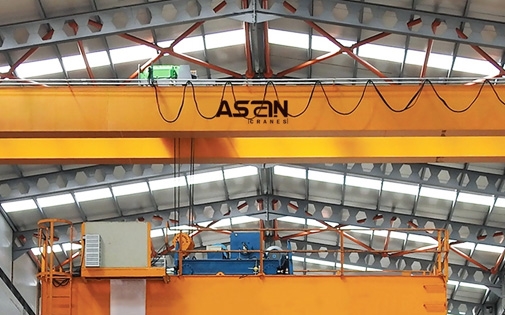 PAGESCONTACT
PAGESCONTACTOverhead Crane

What is Overhead Crane?
An overhead crane is a mechanical lifting device designed to move heavy loads horizontally and vertically within a designated area. Unlike mobile cranes, it operates along a fixed track system, often mounted on the ceiling or on elevated rails.
Overhead cranes are widely used in manufacturing plants, warehouses, and construction sites, allowing operators to transport materials efficiently and safely. These cranes are crucial for industries where precision handling of heavy equipment or raw materials is required.
How To Produce Overhead Crane?
The production of an overhead crane begins with careful design and engineering, taking into account the required load capacity, span, and operational environment.
The process typically involves manufacturing the crane’s main components, including girders, trolleys, hoists, and control systems. High-quality steel is used for structural parts, which are then welded, reinforced, and tested for strength.
Advanced manufacturing techniques such as CNC machining, robotic welding, and precision assembly ensure that each crane meets safety and performance standards. Finally, rigorous load testing is conducted to confirm reliability before delivery to the customer.
Overhead Crane Types
Overhead cranes are versatile machines, and their type depends on operational needs and the structural setup of the facility. The most common types include single girder, double girder, and suspended overhead cranes. Each type offers unique advantages in terms of load capacity, span length, and installation requirements.
Single Girder Overhead Crane
A single girder overhead crane consists of a single beam supporting the hoist, which travels along the length of the crane. It is ideal for lighter loads and shorter spans, providing a cost-effective solution for many manufacturing and warehouse applications. The simplicity of its design ensures lower maintenance and easier installation.
Double Girder Overhead Crane
Double girder cranes feature two parallel beams that support the hoist and trolley, making them suitable for heavy-duty lifting and long-span applications. They provide higher stability, increased load capacity, and better durability under continuous operation. These cranes are commonly used in steel plants, shipyards, and large-scale industrial facilities.
Suspended Overhead Crane
Suspended overhead cranes, also known as monorail or runway cranes, hang from an elevated rail system instead of using supporting columns. This design saves floor space and is particularly useful in facilities where maximum workspace flexibility is required. They are often found in assembly lines, workshops, and automotive plants.
Overhead Crane Price 2025
The price of an overhead crane varies depending on type, load capacity, span, and additional features like automation or remote control. Single girder models typically start from around $10,000 to $50,000, while double girder and heavy-duty cranes can exceed $100,000. Customizations and advanced safety features can further influence pricing. Investing in a high-quality crane ensures durability, safety, and reduced long-term maintenance costs.
Overhead Crane For Sale
Overhead cranes are available through specialized manufacturers, industrial suppliers, and online marketplaces. When purchasing a crane, it is important to evaluate the manufacturer’s reputation, after-sales support, and warranty options. Certified pre-owned cranes are also an option for businesses looking to reduce upfront investment while maintaining operational efficiency.
What is The Function Of Overhead Crane?
The primary function of an overhead crane is to lift, lower, and transport heavy loads across a defined path. It increases efficiency in material handling, reduces labor costs, and enhances workplace safety. Cranes also provide precise load positioning, which is essential for assembly processes, storage, and manufacturing operations.
What is The Difference Between Overhead Crane And Hoist Crane?
While both devices are designed to lift heavy loads, the key difference lies in mobility and application. A hoist crane typically refers to the lifting mechanism (chain or wire rope hoist) that can be mounted on various structures. An overhead crane is a complete system, including the supporting girders, trolley, hoist, and control system, capable of moving loads both horizontally and vertically within a defined area.
What is The Capacity Of The Overhead Crane?
Overhead crane capacities can range from a few hundred kilograms to hundreds of tons. The exact capacity is determined by the crane’s design, girder strength, hoist type, and intended operational use. For example, small single girder cranes may handle 1–10 tons, while large double girder cranes in industrial plants can lift 100 tons or more.
What Are The Applications Of Overhead Crane?
Overhead cranes are used across multiple industries for efficient material handling. Key applications include:
- Manufacturing plants for moving raw materials and finished goods
- Warehouses for loading and unloading heavy pallets
- Steel mills for transporting large steel coils and beams
- Shipyards for lifting ship components and heavy machinery
- Automotive assembly lines for precise positioning of car parts
- Construction sites for handling prefabricated components
- Aerospace industry for moving engines and structural parts
- Recycling facilities for sorting and transporting scrap materials.
Overhead Crane Manufacturers
Leading overhead crane manufacturers focus on quality, safety, and innovation. Many companies provide customized solutions, advanced automation, and integrated safety features. When selecting a manufacturer, factors like global reputation, compliance with international standards (ISO, FEM),and after-sales service are crucial.
Why Buy an Asan Overhead Crane?
Asan Overhead Cranes are known for their reliability, durability, and precision engineering. They offer tailored solutions for both light and heavy-duty applications. With robust construction, advanced control systems, and compliance with global safety standards, Asan cranes help businesses enhance operational efficiency, reduce downtime, and ensure safe material handling in demanding industrial environments.
Professional, powerful and reliable industrial cranes, equipments are our core expertise.
ALL PRODUCTS